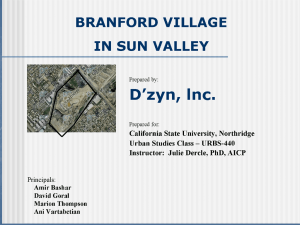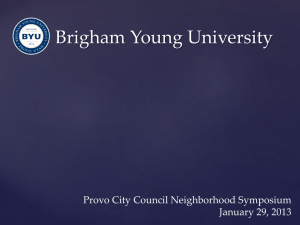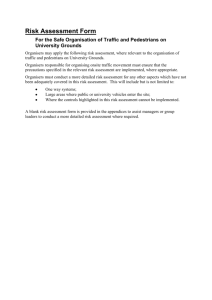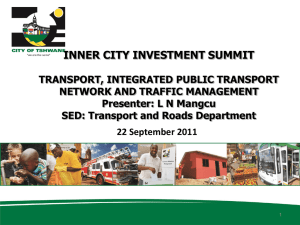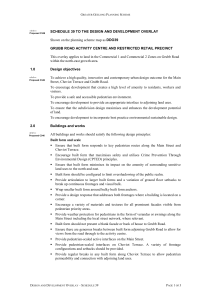Oxford Market Streetscape Improvement report
advertisement
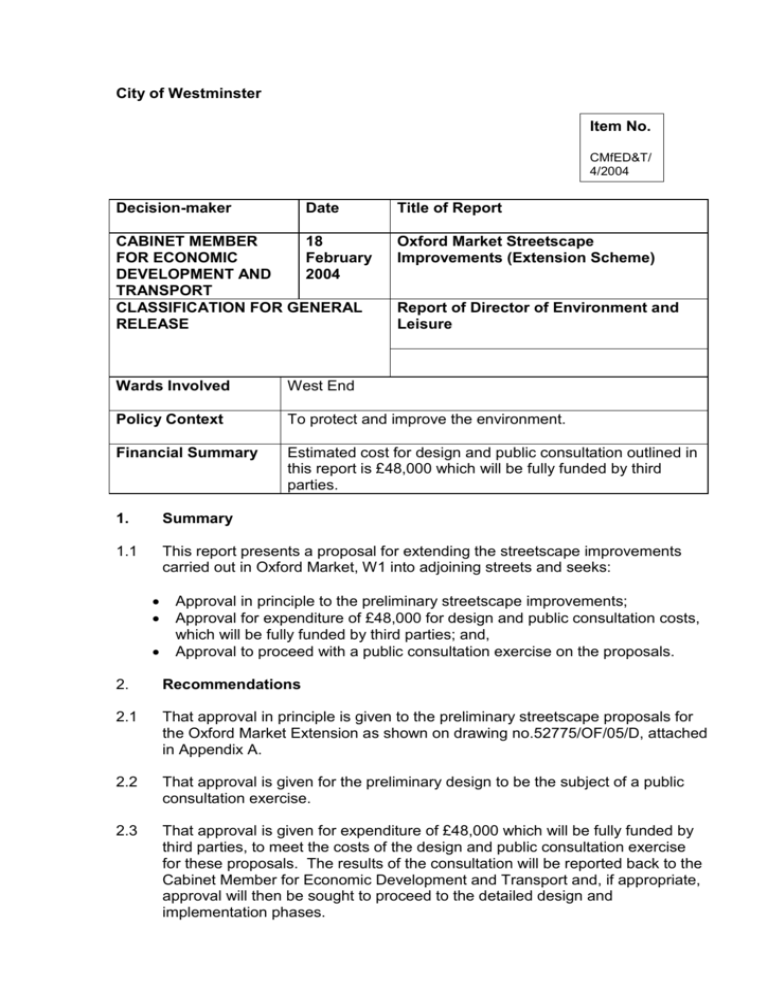
City of Westminster Item No. CMfED&T/ 4/2004 Decision-maker Date CABINET MEMBER 18 FOR ECONOMIC February DEVELOPMENT AND 2004 TRANSPORT CLASSIFICATION FOR GENERAL RELEASE Title of Report Oxford Market Streetscape Improvements (Extension Scheme) Report of Director of Environment and Leisure Wards Involved West End Policy Context To protect and improve the environment. Financial Summary Estimated cost for design and public consultation outlined in this report is £48,000 which will be fully funded by third parties. 1. Summary 1.1 This report presents a proposal for extending the streetscape improvements carried out in Oxford Market, W1 into adjoining streets and seeks: Approval in principle to the preliminary streetscape improvements; Approval for expenditure of £48,000 for design and public consultation costs, which will be fully funded by third parties; and, Approval to proceed with a public consultation exercise on the proposals. 2. Recommendations 2.1 That approval in principle is given to the preliminary streetscape proposals for the Oxford Market Extension as shown on drawing no.52775/OF/05/D, attached in Appendix A. 2.2 That approval is given for the preliminary design to be the subject of a public consultation exercise. 2.3 That approval is given for expenditure of £48,000 which will be fully funded by third parties, to meet the costs of the design and public consultation exercise for these proposals. The results of the consultation will be reported back to the Cabinet Member for Economic Development and Transport and, if appropriate, approval will then be sought to proceed to the detailed design and implementation phases. 3. Background Information 3.1 In autumn 1999 the City Council implemented a package of streetscape improvements in Market Place, East Marylebone, also known as Oxford Market (see location plan, Figure 1 attached in Appendix A). The improvement package was promoted and funded by a consortium of local landowners, principally comprising Great Portland Estates and Joint London Holdings, at a cost of £655,000. The initiative was aimed at enhancing an area, predominantly characterised by fashion wholesale showroom units, by increasing the mix of uses and street activity, providing scope for additional support services for the local fashion industry and attracting more visitors to what is regarded as a backwater of Oxford Street (east). 3.2 The improvements were designed to create a ‘piazza-style’ precinct and included the introduction of one-way traffic flows and restrictions to vehicle access; speed tables and pavement build-outs, new integrated street furniture, lighting and tree planting. The scheme was progressed in conjunction with an amendment to the City Council’s adopted UDP planning policy on showrooms (SS8) to allow for some changes of use of vacant showrooms to retail (A1) and restaurant/bar (A3) activities within a limited area. The new precinct was envisaged as providing the fashion industry with a point of interest and facilities that would enliven the area and in turn attract new, more prestigious fashion showrooms into the area. The final cost of works was met through a combination of sponsorship funding and Section 106 agreements arising from the consequent planning approvals. 3.3 The Oxford Market Initiative (Phase 1) is generally regarded as a success and is acknowledged as such in the City Council’s replacement UDP. Cafés, restaurants and outdoor tables and chairs have become popular with workers, businesses and shoppers. Furthermore, its upgraded streetscape improvements have provided a kick-start to local business re-investment. However, there has been an increase in the number of reported crimes, mainly relating to the theft of personal property, i.e. handbags and mobile phones from cafes and tables and chairs outside the premises. 3.4 In view of the success, the consortium has again approached the City Council proposing sponsorship of an extension of the streetscape improvement scheme in adjoining Eastcastle Street, Great Titchfield Street, Market Place (south west) and Market Court (see location plan, Figure 1). The City Council’s term consultants were commissioned to carry out a feasibility study for the extension, with the costs being met in full by third parties. The objectives for Phase 2 are to: provide a more attractive street environment; improve pedestrian safety and security; remove street clutter and minimise the visual and physical impact of essential street furniture; maintain and regularise vehicle access and servicing; and, maintain, or minimise the impact on, residents’ and visitor on-street parking. 3.5 A brief review of Phase 1, investigating any shortcomings in the design approach and choice of materials, street furniture, planting etc, has been undertaken by the term consultants. In general, their findings support the view that the initiative has proved successful in upgrading and enlivening the area. 3.6 However, the review identified that the scheme has not been as successful in reducing street clutter. Street furniture has remained in the middle of the pavements and some new street furniture has not been placed in line with the overall design. Phase 2 of the scheme seeks to reduce street clutter, see section 4 below. 3.7 In terms of detailed issues, the review found that although the pavement is generally well designed, the variations in the pattern and choice of colour are not consistent with the surrounding materials. Therefore, some changes are proposed to the design and palette of materials for Phase 2. It is intended to use smooth granite setts on pedestrian crossing points and to install tactile paving of a similar colour to the surrounding footways where necessary. This would create a more consistent and simple highway layout. 4. Proposed Improvements in the Oxford Market Area (Phase 2) Existing Situation 4.1 As set out in Section 3, the Oxford Market area has long been associated with the clothing trade. However, the area has recently experienced a decline in the extent and use of the wholesale showrooms which has led to a corresponding decline in levels of activity and vitality in the area generally. 4.2 Great Titchfield Street starts at Oxford Street in the south and continues northwards towards Euston Road. Eastcastle Street is a one-way street with the traffic travelling southwest bound. The Phase 2 proposal includes two sections of these streets, located to the northeast of Phase 1. 4.3 The carriageways on both Great Titchfield Street and Eastcastle Street are asphalt. The footways on both sides of the streets are paved with mastic with granite kerbs. There are no trees along the two sections of the streets and a limited amount of street furniture. 4.4 A traffic survey shows that both streets carry substantial through traffic during both day and night. 4.5 A pedestrian survey identified that most pedestrian movements occur during the lunchtime peak hour along Great Titchfield Street with the junction with Margaret Street being the busiest (see Appendix B for survey details). 4.6 A delivery survey was conducted by interview with businesses in the street. Of those interviewed the majority were in favour of improving the area. Proposed Improvements 4.7 The proposal to be consulted upon is shown on drawing No.52775/OF/05/D attached as Appendix A. In summary the proposals aim to: extend the benefits of the Phase 1 scheme to its north east corner where at present the improved space is not defined and ‘leaks away’ in design qualities; increase pedestrian space to improve safety; improve parking and loading facilities; make a further positive contribution to the vitality of the area by encouraging economic activity in the locality; improve pedestrian crossing facilities at Great Titchfield Street up to the junction of Margaret Street; improve pedestrian safety at the junction of Eastcastle Street and Winsley Street; and, upgrade highway surfacing in Market Place (east) and Market Court. The main features of the proposal are: narrower carriageways with kerb build-outs on both streets; resurfaced footways in Artificial Stone Paving with granite kerbs and asphalt carriageways to match Market Place Phase 1; a pinch point at the eastern entrance, west of Winsley Street, to mark the entrance to the area and to improve pedestrian safety; rationalised and increased on-street parking; provision of new bicycle parking; provision of loading bays; modification of traffic orders for loading/unloading bays within Phase 1 to allow for evening parking in the bays outside restricted hours; planting of trees along both streets; improved street lighting throughout the area to match Phase 1; to introduce a new blue badge disabled parking bay and dropped kerbs for the benefit of people with disabilities; and, to introduce a raised table at the junction of Great Titchfield Street/Eastcastle Street/Market Place to increase pedestrian safety. Parking Implications 4.8 The proposed scheme will have a small but positive impact on the parking provision in the area (see table 1 over). One new metered space and one new disabled blue badge holders parking space are proposed. This is likely to generate a small increase in parking revenue. However, the proposal will reduce the existing number of free evening parking spaces as the total length of single yellow lines will be reduced from 110 to 50 metres which equates to approximately 12 overnight spaces lost. In summary, the proposal will not have an adverse impact on on-street parking provision. Parking Residents Metered Disabled Taxi Motorcycle Existing spaces 0 2 0 0 0 Proposed Spaces 0 3 1 0 0 Table 1 – Parking Changes Implications for servicing and access 4.9 The proposed scheme introduces loading bays for servicing in the area. These loading bays will improve traffic safety as well as reduce problems with vehicle loading from the street which interfere with traffic flows. The traffic management order for the loading bays will allow free night time parking in the bays outside restricted hours. Implications for pedestrian safety and security as well as vehicle safety 4.10 The proposal will improve pedestrian safety by increasing footway space and providing a zebra crossing in the junction with the most significant pedestrian movements to the area and a raised table at the junction of Great Titchfield Street/Eastcastle Street/Market Place. 4.11 Pedestrian security in the area will be improved by increased lighting levels. Implications for street clutter and essential street furniture 4.12 The scheme will reduce street clutter as all street furniture will be thoughtfully relocated or removed. Lamp posts and bollards will be used for essential signage where possible. The new regulations on signage of double yellow and single yellow lines will also have a positive impact from the point of view of reducing street clutter. Pedestrian Scheme Appraisal 4.13 On 13 June 2000 the Planning and Transportation Committee endorsed a methodology for appraising highway and traffic schemes which result in an increase to pedestrian space. The Committee also agreed that no future scheme increasing pedestrian space should proceed unless the pedestrian appraisal results in benefits outweighing disbenefits. 4.14 The pedestrian scheme appraisal process seeks to ensure that the development of highway and transportation schemes are evaluated against agreed criteria and objectives. In particular, as well as focusing on the transportation and urban design issues, it allows for a much greater focus on how increased pedestrian space might be used or abused, managed and maintained. This more holistic approach allows for consideration in the development of the design, of a wide range of issues such as risk of crime and anti social behaviour, unauthorised or illegal activities, the consequential impact on enforcement resources and maintenance, cleansing, and waste collection costs. 4.15 A Pedestrian Scheme Appraisal has been undertaken for the proposal set out in Section 4. The conclusion in general was that the positive impact of the proposals is greater than the negative aspects. See Appendix C for the summary sheet. 4.16 The appraisal identified positive impacts for: Townscape and design; Transport and access; Parking; and, Street maintenance. The appraisal identified negative impacts for: Authorised land use and activities; Enforcement and unauthorised activities; and, Crime and anti social behaviour. Oxford Market phase 1 presents greater potential for negative impact in relation to crime and unauthorised activities and yet is accepted as an improvement to the area. The local Crime Prevention Officer for the area does not consider antisocial behaviour to be of great concern within the area including phase 1. It is therefore reasonable to predict that phase 2 would tend overall to provide more of a positive impact than a negative one. 5. Programme and Consultations 5.1 The Cabinet Member for Street Environment, Councillor Judith Warner, and the Chairman of the Planning and Development Committee, Councillor Angela Hooper, have been consulted on the proposals. 5.2 Councillor Judith Warner has no comments on the proposals. 5.3 Councillor Angela Hooper raised the question of whether Great Portland Estates and Joint London Holdings are seeking change of use for some of their properties. This is the case for certain properties. However, the issues surrounding such requests will be considered through the normal planning process. 5.4 Councillor Hooper also questioned how the costs of the works would be met. To clarify, all costs will be met in full by the consortium. This will be secured by means of a legal agreement in the form of a ‘letter of intent’ (pursuant to s278 of the Highways Act 1980). Councillor Hooper has no objections to the consultation exercise being completed. 5.5 Phase 2 proposals, if approved, would be the subject of a consultation exercise with local residents, businesses, the relevant amenity societies, Ward Councillors and section 6 consultees. Figure 2, attached in Appendix A identifies the proposed area for the consultation exercise. 5.6 Subject to approval of this report it is intended to carry out the consultation exercise during March/April 2004 and report the results of the consultation back to the Cabinet Member for Economic Development and Transport in May 2004 when approval will be sought, if appropriate, to proceed to the detailed design and implementation phases. 6. Financial Implications 6.1 The design and public consultation costs are estimated to be £48,000. These costs will be met in full by the Consortium referred to in para 3.1 in advance of any design or consultation being undertaken. 6.2 The estimated cost of the streetscape improvements based upon the preliminary design is £278,000 and is broken down as follows: Works Consultant fees Client costs Contingencies Risk allowance Inflation allowance £ 163,000 £ 45,000 £ 13,000 £ 36,000 £ 13,000 £ 8,000 Total £ 278,000 6.3 Prior to commencement of the works, the Council will secure a legal agreement, in the form of a ‘letter of intent’ (pursuant to s278 of the Highways Act 1980) from the consortium to meet all costs and to ensure the interests of the City Council are protected. 6.4 The increase in meter parking is likely to provide an increase of approximately £144 per week in revenue to the Parking Place reserve Account (PPRA). 7. Staffing Implications/Staff Consultation/TUPE Implications 7.1 There are no staffing or Union implications arising from this report. 8. Business Plan Implications 8.1 There are no specific references to these matters in the 2003/2004 Planning and Transportation Business Plan. 9. Legal Implications 9.1 Before any works are carried out, the City Council will enter into a legal agreement in the form of a ‘letter of intent’ (pursuant to s278 of the Highways Act 1980) to meet all costs incurred by the developer. 10. Ward Member Comments 10.1 Ward Members have not been consulted on these proposals. 11. Conclusions 11.1 The proposals for extending the Oxford Market streetscape improvements should improve the movement and safety of pedestrians and upgrade and enliven the area to match the success of Phase 1. 11.2 The estimated cost of developing the proposals and carrying out a consultation exercise is £48,000, which will be met in full by the consortium in advance of any works being carried out. 11.3 Although the pedestrian scheme appraisal highlighted concern over crime, unauthorised activities, and antisocial behaviour in respect of Phase 1, it is recommended that approval be given to the preliminary design and to proceed with the consultation exercise and initial design so that the views of local residents, Ward Members and businesses can be obtained. 11.4 The Cabinet Member for Economic Development is recommended therefore to approve the proposals identified in this report, the carrying out of a consultation exercise and the capital expenditure necessary to implement them. If you have any queries about this report or wish to inspect one of the background papers please contact Jennifer Gardner on 020 7641 2034 (email:jgardner1@westminster.gov.uk) BACKGROUND PAPERS The documents referred to in compiling the report are: Report to Traffic Sub-Committee of 23 September 1998 on the Oxford Market Initiative. Westminster City Council Project Brief 2065 Oxford Market Extension July 2001. Oxford Market Extension, Feasibility Report (Volumes l – lll) October 2002 by Parkman Limited for Westminster City Council. Pedestrian Scheme Appraisal in respect of Phase 1 Appendix A PROPOSED LAYOUT DRAWING 52775/OF/05D LOCATION PLAN CONSULTATION AREA – FIGURE 2 Appendix B SURVEY DETAILS Appendix C PEDESTRIAN SCHEME APPRAISAL SUMMERY SHEET For completion by Cabinet Member Declaration of Interest I have no interest to declare in respect of this report Signed ……………………………. Date ……………………………… NAME: I have to declare an interest State nature of interest ……..…………………………………………… ……………………………………………………………………………….. Signed ……………………………. Date ………………………………… NAME: (N.B: If you have an interest you should seek advice as to whether it is appropriate to make a decision in relation to this matter.) For the reasons set out above, I agree the recommendation(s) in the report entitled Oxford Market Streetscape Improvements (Extension Scheme) and reject any alternative options which are referred to but not recommended. Signed ……………………………………………… Cabinet Member for ………………………………. Date ………………………………………………… If you have any additional comment which you would want actioned in connection with your decision you should discuss this with the report author and then set out your comment below before the report and this pro-forma is returned to the Secretariat for processing. Additional comment: ………………………………………………………………… …………………………………………………………………………………………. …………………………………………………………………………………………. NOTE: If you do not wish to approve the recommendations, or wish to make an alternative decision, it is important that you consult the report author, the Director of Legal and Administrative Services, the Chief Financial Officer and, if there are staffing implications, the Head of Personnel (or their representatives) so that (1) you can be made aware of any further relevant considerations that you should take into account before making the decision and (2) your reasons for the decision can be properly identified and recorded, as required by law. Note to Cabinet Member: Your decision will now be published and copied to the Members of the relevant Overview & Scrutiny Committee. If the decision falls within the criteria for call-in, it will not be implemented until five working days have elapsed from publication to allow the Overview and Scrutiny Committee to decide whether it wishes to call the matter in.
